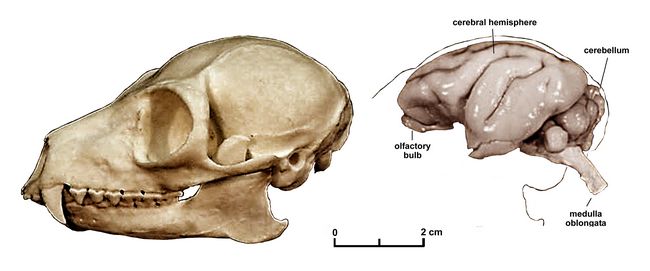Athena Review Image Archive ™
Lemur catta skull and brain

Skull and brain of the ring-tailed lemur (Lemur catta)
The ring-tailed lemur (Lemur catta) is a strepsirrhine primate or prosimian, and the most recognized lemur, due to its long, black and white ringed tail. It belongs to Lemuridae, one of five lemur families, and is the only member of the Lemur genus. Like all lemurs it is endemic to the island of Madagascar.
The name derives from the Latin lemures, for ghosts that were exorcised during the Lemuria festival of ancient Rome. According to Linnaeus(1758), the name was selected because of the nocturnal activity and slow movements of the slender loris. While first intended for slender lorises, the term became used exclusively for Malagasy primates, called "lemurs" since the late 18th century.
Lemur catta is a relatively large lemur with an average weight of 2.2 kg (4.9 lbs). Its slender, padded fingers are semi-dexterous with flat, human-like nails. The short thumb is not opposable since the ball of the joint is fixed in place. The dentition is 2.1.3.3, with small upper incisors and long upper canines which exhibit sexual dimorphism, males having slightly larger canines than females.
Lemur catta lives in gallery forests and spiny scrubland in the southern regions of the island. It is omnivorous, primarily eating fruits and leaves, especially of the tamarind tree (Tamarindus indica). The animal is diurnal, being active exclusively in daylight hours. Unlike most diurnal primates, but like all strepsirhine primates, the ring-tailed lemur has a tapetum lucidum, or reflective layer behind the retina of the eye, that enhances night vision. The ring-tailed lemur is the most terrestrial of extant lemurs. It is highly social, living in groups of up to 30 individuals, and uses numerous vocalizations including group cohesion and alarm calls.
Lemur catta, the ring-tailed lemur, shares many similarities with ruffed lemurs (genus Varecia) and true lemurs (genus Eulemur), and its skeleton is nearly indistinguishable from that of Eulemur. Based on genetic evidence lemurs are more closely related to each other than to other Strepsirrhine primates. It is likely that a small ancestral population came to Madagascar via a single rafting event between 50 and 80 million years ago. The branching of the family Lemuridae has been dated to 26.1 ±3.3 mya.
References:
Linnaeus, Carolus. 1758. Systema Naturae.
Tattersall, I. 1982. The Primates of Madagascar. Columbia University Press. pp. 43–46.
Wilson, D.E, and E. Hanlon 2010. Lemur catta (Primates: Lemuridae). Mammalian Species. 42 (854)
Copyright © 1996-2020 Rust Family Foundation (All Rights Reserved).